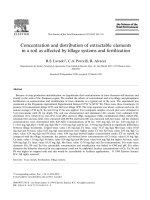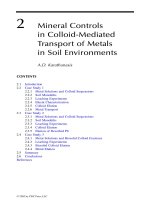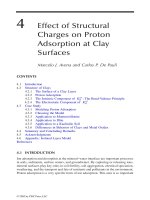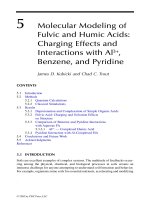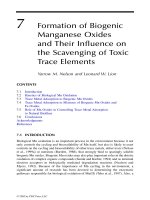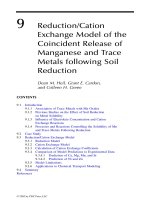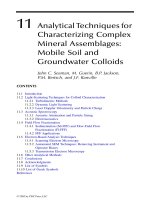Availability of micronutrient cations in soils as influenced by phosphorus fertilization - A review
Bạn đang xem bản rút gọn của tài liệu. Xem và tải ngay bản đầy đủ của tài liệu tại đây (192.19 KB, 7 trang )
Int.J.Curr.Microbiol.App.Sci (2019) 8(9): 1946-1952
International Journal of Current Microbiology and Applied Sciences
ISSN: 2319-7706 Volume 8 Number 09 (2019)
Journal homepage:
Review Article
/>
Availability of Micronutrient Cations in Soils as Influenced
by Phosphorus Fertilization- A Review
Harpreet Kaur*
Department of Soil Science, College of Agriculture, Punjab Agricultural University, India
*Corresponding author
ABSTRACT
Keywords
root development,
cell division,
flowering seed and
fruit formation
Article Info
Accepted:
20 August 2019
Available Online:
10 September 2019
Phosphorus and micronutrients (zinc, copper, iron and manganese) are the
essential nutrients which are required for normal plant growth. Phosphorus
and all micronutrient cations are mutually antagonistic in certain
circumstances which can cause yield reductions in many crops due to their
deficiencies. Deficiencies typically happen when a nutrient is available in
small amounts. In this phenomenon, the nutrient is present in marginal to
normal levels but the antagonizing nutrient is available in such a large
amount that it induces the deficiency of the other. The effect of phosphorus
application on the availability of micronutrients showed that the application
of phosphorus decreases the concentrations of Fe, Zn, Cu and Mn in the
soils which indicate negative interactions between P and micronutrient
cations while the concentration of Mn increases in some cases indicating
synergistic as well antagonistic effect of P application on Mn availability in
soils to plants.
Introduction
Phosphorus has been considered to be the
kingpin in agriculture because it plays a
pivotal role in increasing crop production and
improving the quality of crops. It is the second
major essential element and is required by
plants for root development, cell division,
flowering seed and fruit formation (Brady,
1984). Phosphorus in soils occurs in the form
of primary and secondary orthophosphate.
Most possibly all crops take up H2PO4- more
readily than HPO4-- and above pH 7.0 the
relative concentration of the divalent ion is
greater than that of monovalent ion. India is
the world’s third largest producer of
phosphatic fertilizers and second largest
consumer after China (Prasad, 2012). If large
amounts of P are supplied in soils, its luxury
uptake may disturb the ratios of P to other
nutrients including micronutrients (Tagliavini
et al., 1991). The present day modern
agriculture aims at achieving maximum
production per unit area per unit time per unit
cost. This has created an imbalance of
nutrients in soils and crops not only with
1946
Int.J.Curr.Microbiol.App.Sci (2019) 8(9): 1946-1952
respect to macronutrients but also the
micronutrients. Rice-wheat is the major
cropping system of Punjab and normally
phosphorus is applied to wheat. However, in
some areas farmers are applying phosphorus
to both the crops. But only one- third of
applied P is taken up by the current crop that
may lead to the buildup of P in plough layer of
soils over a period of time. At present only
36% of the area in Punjab is low in P
supplying capacity (Sharma et al., 2011).
Build up of P in soils can affect pH, CEC and
surface charge of soils which in turn may alter
the equilibria of micronutrients among their
various chemical pools. Not only this, build up
of P in soils may lead to various types of
nutrient interactions in soils and plants.
Nutrient interactions in crop plants are
probably one of the most important factors
affecting the yields of annual crops. An
interaction takes place when the supply of one
of the nutrients affects the absorption,
distribution or function of the other and it may
be negative, positive or neutral (Fageria,
2001). Thus, depending upon the nutrient
supply, the interactions between nutrients can
either induce deficiencies or toxicities and can
modify the growth response. The plants
require essential nutrients viz., primary,
secondary and micro nutrients. One of the
fertilizers that are used a lot in various crop
plants is phosphorus, which is applied as
phosphorus fertilizers to the soil. The
deficiency of micronutrients may emerge
when the supply of micronutrients to the soil
is less compared to removal through crop
harvest which in turn limits crop productivity
(Shukla et al., 2009). If large amounts of P are
supplied in soils, its luxury uptake may disturb
the ratios of P to other nutrients including
micronutrients (Tagliavini et al., 1991). Thus,
an understanding of the interaction of
phosphorus with other nutrients can be of help
to maintain a balanced supply of nutrients to
get the optimum crop yields.
Effect of phosphorus fertilization on zinc in
soil
Zinc is an important essential element present
in plant enzymatic systems. Among the
interactions
involving
macro
and
micronutrients the interaction between
phosphorus and zinc is of greatest potential
significance. This interaction is often negative
(antagonistic) especially when a soil is
deficient in both the nutrients but only one of
them is applied through fertilizers. Das et al.,
(2005) in a greenhouse experiment at the
Indian Institute of Horticultural Research
(IIHR), Bangalore reported the decrease in the
amount of Zn due to combined application of
P and Zn might be explained as the
antagonistic effect between them. It has been
reported that the interaction between Zn and P
occurred in soil because added P decreased the
available Zn content in plants. The amount of
P and Zn in soils showed an increase with
their separate applications either as soil or
foliar spray while that of the same value
significantly decreased both in soils and plants
due to their combined applications, suggesting
a mutual antagonistic effect between Zn and P
affecting each other's availability in soil and
content in the stevia plant. Meena et al.,
(2019) observed that Zinc availability
decreases with application of each successive
phosphorus level but it was increased with
application of zinc. High levels of available
phosphorus in soil or high dose of phosphorus
application may induce zinc deficiency in the
soil characterized by low concentration of
available zinc. In an incubation study, Mandal
and Haldar, (1980) observed that application
of phosphorus @ 5 and 10 mg kg-1 soil in
lowland rice soils of West Bengal significantly
decreased the contents of DTPA-extractable
Zn, Cu, Fe and Mn. The rate of decrease
gradually reduced with increasing period of
incubation from 10 to 70 days. They further
observed that the depressive effect of P on
1947
Int.J.Curr.Microbiol.App.Sci (2019) 8(9): 1946-1952
extractable Zn was more pronounced on native
rather than applied Zn. Manchanda et al.,
(2012) observed a steep fall in DTPA- Zn
when P: Mn ratio in soil was 6.0 and reported
that a P: Mn ratio of 3.28 in soil produced
80% of the maximum dry matter yield of
shoot of wheat. Furthermore, P-Zn
relationship in soils and plants may also be
governed by factors like organic matter
(Nayak and Gupta, 2000), plant parts (Reddy
and Yadav, 1994), plant species and growth
stages (Islam et al., 2005). Dwivedi et al.,
(1975) observed P induced Zn deficiency in
corn when P was applied @ 120 mg kg-1 soil
in a Zn deficient soil (DTPA- Zn 0.2 mg kg1
soil). They further observed that high levels
of P rendered the applied n unavailable to
plants by immobilizing almost 40% or more of
the total Zn absorbed in roots and 20 per cent
or more at the nodes of the stem. In a nutrient
culture experiment, Soltangheisi et al., (2013)
observed that Zn deficiency in sweet corn can
enhance P uptake and translocation to such an
extent that P may accumulate to toxic levels in
its leaves. Mishra and Abidi, (2010) reported
that P and Zn application had a synergistic
impact on the 1000-seed weight and protein
content of the wheat varieties.
Effect of phosphorus fertilization on copper
in soil
Awan and Abbasi, (2000) observed that
phosphorus
application
increased
P
concentration while decreased the copper
concentration in the maize plants in sandy
loam soil, leading to conclude that an
interaction between P and Cu in soil occurs
which effect the production of maize fodder
significantly. Mandal and Haldar, (1980)
reported that the decrease in uptake of Zn, Cu
and Fe by rice because of P application was
due to decrease in the availability of these
nutrients in soils. In a greenhouse study,
Haldar and Mandal, (1981) observed that
application of phosphorus in alluvial rice soils
significantly increased the dry matter yield of
root, shoot and grain. But it decreased the
concentration of Zn, Cu, Fe and Mn in both
roots and shoots. This decrease in the
concentration of elements in shoots was not
due to the dilution effect or to the reduced rate
of translocation from roots to tops. They
observed that this decrease was more due to
the changes in their availability in soil due to
P application. Application of 100 kg P ha-1
significantly decreased the Cu concentration
in maize plants (Awan and Abassi, 2000).
Similarly, an antagonistic effect of P on Cu
concentration of wheat (Shukla and Singh,
1979; Javadi et al., 1991) has been observed.
Effect of phosphorus
manganese in soil
fertilization
on
A synergistic (Kuo and Mikkelsen, 1981) as
well antagonistic (Soni et al., 2000) effect of P
fertilization on Mn availability in soils to
plants has been reported. Singh et al., (2005)
observed that availability of Mn in a near
neutral non-calcareous soil was increased
when the build up of available P in soil
exceeded 60 mg P kg-1 soil. Chatterjee et al.,
(1983) reported a significant decrease in
DTPA extractable Mn with P application @
100 mg P kg-1 in an acidic soil (pH 6.5)
incubated for 30 days. However, in an alkaline
soil (pH = 7.6), Mamo and Parson, (1987)
reported a significant increase in DTPA
extractable Mn with P application @ 400 mg
P kg-1 soil incubated for 28 days. Misra and
Mishra, (1968) reported that P application to
alkali soils decreased the retention of Mn by
soil colloids and increased the availability of
Mn. However, in near neutral soil (pH = 7.3)
having 11.5 ppm DTPA-Mn, the availability
of Mn in soil was not influenced by P
application even up to 120 kg P2O5 ha-1 (Rao
et al., 1984). Singh et al., (2005) observed a
significant increase in dry matter yield of root
and shoot of wheat with graded levels of
applied P in a Typic Haplustept but P and Mn
1948
Int.J.Curr.Microbiol.App.Sci (2019) 8(9): 1946-1952
concentration in both root and shoot were
inversely related with each other. Soni et al.,
(2000) reported that when P and Mn was
applied @ 0 to 60 mg P kg-1 soil and 0 to 50
mg Mn kg-1 soil respectively in a reclaimed
sodic soil (pH = 8.7) then increasing levels of
P decreased the concentration of Mn in wheat
at each level of applied Mn. Recovery of
added Mn was lower at higher levels of P
application. However, Karelia, (1990) and
Patel, (1992) observed that application of P
significantly increased the content and uptake
of Mn by wheat crop.
Effect of phosphorus fertilization on iron in
soil
An antagonistic effect of P on Fe
concentration in moong bean has been
observed (Yadav et al., 2002). Dhaliwal and
Mandal, (2019) reported that the mean
available Fe in soil at harvest extracted by
DTPA decreased significantly by 3.2%, 4.5%,
and 6.9%, respectively, over control with
application of 100, 200 and 400 mg P kg−1
soil. So DTPA-Fe was significantly negatively
correlated with Olsen P (r = −0.833**). The
decrease in availability of Fe with P
fertilization may be due to the formation of
Fe–phosphates in soil (Olsen, 1972). Intensive
cultivation of high-yielding cultivars with
heavy applications of nitrogen (N),
phosphorus (P), and potassium (K) fertilizers
leads to the occurrence of Fe and Mn
deficiencies (Cakmak, 2002). Khan and
Zande, (1976) and Badhe and Mundwaik,
(1982) reported a significant decrease in Fe
content of wheat plant with increasing dose of
P fertilizer. Karelia, (1990) found that
application of P at its highest levels (P 180)
significantly decreased the Fe content in grain
and straw of wheat crop, whereas Fe uptake
by grain and straw as well as its total uptake
were significantly higher at P 120 level. Patel,
(1992) observed that Fe content in grain was
found to increase up to 60 kg P2O5 ha−1 of P
application level but further addition of P (90
kg P2O5 ha−1) showed negative effect on Fe
content.
Adriano et al., (1971) reported that in corn
seedlings with high P levels, shoot growth was
increased only by high Zn. The most marked
interaction at high P levels was between Fe
and Zn which mutually antagonized
translocation more than absorption. Dev et al.,
(1983) reported that application of 7.5 mg P
kg-1 soil P enhanced the Mn concentration of
chickpea while its concentration decreased
when P was applied @ 15 and 30 mg kg-1 soil.
In a field experiment Zhang et al., (2012)
observed that application of phosphorus up to
400 kg P ha-1 did not influence the DTPAextractable zinc, copper, iron and manganese
in a alkaline calcareous loam soil under the
wheat crop. However, they observed a
significant reduction in the concentration of
zinc in wheat grain by 17 to 56 per cent by P
application. But the accumulation of shoot
iron, copper and manganese was increased
with applied P. Li et al., (2007) also did not
observed any significant effect of P
application
on
DTPA
extractable
micronutrient cations in soil under long term
inorganic and organic fertilizer application.
Goel and Duhan, (2014) observed a significant
decrease in DTPA extractable Zn, Cu, Fe and
Mn with application of varying levels of P (037.5 kg P ha-1) to a Typic Torripsamment of
Hisar. In an alkaline calcareous soil of
Pakistan, Ali et al., (2014) observed a
decrease in the availability of Zn and Cu but
an increase in the availability of Fe and Mn
with that application of P (0-150 kg P ha-1).
References
Adriano. D. C., Paulsen, G. M and Murphy, L.
S.
1971.
Phosphorus-iron
and
phosphorus-zinc relationships in corn
(Zea mays L.) seedlings as affected by
mineral nutrition. Agron J 63:36-39.
1949
Int.J.Curr.Microbiol.App.Sci (2019) 8(9): 1946-1952
Ali, F., Sadiq, A., Ali, I., Amin, M. and Amir,
M. 2014. Effect of applied P on the
availability of micronutrients in
alkaline-calcareous soil. J Environ and
Earth Sci 4:2224-3216.
Awan, Z. I. and Abbasi, M. K. 2000.
Interactive effect of phosphorus and
copper on maize growth. Pakistan J
Agric Res 16:105-108.
Badhe, N. N. and Mundwaik, S. P. 1982.
Effect of phosphorus concentration on
Fe, Zn, Cu and Mn utilization by
sorghum and wheat. Journal of
Maharashtra Agricultural Universities
7 (2):148–150.
Brady, N.C. 1984. The nature and properties
of soils, (9th Edition) Macmillan
Publishing inc., New York, USA.
Cakmak, I. 2002. Plant nutrition research:
Priorities to meet human needs for
food in sustainable ways. Plant and
Soil
247:3–24.
doi:10.1023/A:
1021194511492.
Chatterjee, A. K., Mandal, L. N. and Haldar,
M. 1983. Effect of phosphorus and
zinc application on the extractable Zn,
Cu, Fe, Mn and P in waterlogged rice
soils. J Indian Soc Soil Sci 31:135-137.
Das, K., Dang, R., Shivananda, T. N. and Sur,
P. 2005. Interaction effect between
phosphoprus and zinc on their
availability in soil in relation to their
contents in stevia (Stevia rebaudiana).
Scientific World J 5:490-495.
Deo, C. and Khandelwal.2009. Effect of Zn
and P on yield, nutrient uptake and oil
content of mustard grown on the
gypsum- treated sodic soil. J Indian
Soc Soil Sci 57:66-70
Dev, S., Kaushik, R. D. and Gupta, V. K.
1983. Relationship between P and Mn
in Chickpea. Pl Soil 72:85-90.
Dhaliwal, S. S. and Mandal, A. 2019.
Transformations and Availability of
Iron to wheat as Influenced by
Phosphorus
and
Manganese
Fertilization in a Typic Haplustept
Soil. Communication in soil science
and
plant
analysis
/>.1603308.
Dwivedi, R. S., Randhawa, N. S. and Bansal,
R. L. 1975. Phosphorus- Zinc
interaction I. Sites of immobilization
of Zn in maize at a high level of
phosphorus. Pl Soil 43:639-648.
Fageria, V. D. 2001. Nutrient interaction in
crop plants. J Pl Nutr 24:1269-1290.
Goel, V. and Duhan, B. S. 2014.
Ashwagandha (Withania somnifera L.
Dunal) crop as affected by the
application of farm yard manure
(FYM) and inorganic phosphorus in
typic torripsamment of Hisar. Afr J
Biotechnol 13:743-748.
Haldar, M. and Mandal, L. N. 1981. Effect of
phosphorus and zinc on the growth and
phosphorus, zinc, copper, iron and
manganese nutrition of rice. Pl Soil
59:415-425.
Islam, M. N., Hoque, S. and Islam, A. 2005.
Interactive effect of P and Zn in wheat,
rice and mungbean. J Indian Soc Soil
Sc. 53:221-227.
Javadi, M., Beuerlein, J. E. and Arscott, T. G.
1991. Effects of P and Cu on factors
influencing
nutrient
uptake,
photosynthesis and grain yield of
wheat. Ohio J Sci 91:191-194.
Karelia, G. N. 1990. Response of wheat to P
and Zn fertilization and their residual
effect on bajra and jowar fodder
andtheir availability in the soil. Ph.D.
Thesis, Gujarat Agricultural University
Sardar
Krushinagar,
Gujarat.
10.1099/00221287-136-2-327.
Khan, A. A. and Zande, G. K. 1976.
Correlation of soil test values with the
response of maize and sorghum to
available Zn and P. Indian Journal of
Agricultural Sciences 46:259–265.
1950
Int.J.Curr.Microbiol.App.Sci (2019) 8(9): 1946-1952
Kuo, S. and Mikkelsen, D. S. 1981. Effect of
P and Mn on growth response and
uptake of Fe, Mn and P by sorghum. Pl
Soil 62:15-22.
Li, B. Y., Zhou, D.M., Cang, L., Zhang, H. L.,
Fan, X.H., and Qin, S. W. 2007. Soil
micronutrient availability to crops as
affected by long-term inorganic and
organic fertilizer applications. Soil Till
Res 96:166-173.
Mamo, T. and Parsons, J. W. 1987.
Phosphorus micronutrient interactions
in teff. Trop Agric 64:3009-3012.
Manchanda, J. S., Singh, A. and Dhaliwal, S.
S. 2012. Chemical pools of Zn and
their availability to wheat in a Typic
Haplustept as influenced by P and Mn
fertilization. J Indian Soc Soil Sci
60:156-162.
Mandal, L. N. and Haldar, M. 1980).
Influence of phosphorus and zinc
application of the availability of zinc,
copper,
iron,
manganese
and
phosphorus in water logged rice soils.
Soil Sci 130: 251-257.
Meena, S., Lahariya, G. S., Khatik, P. and
Kumar, K. 2019. Interactive Effect of
Phosphorus and Zinc on Yield, Quality
and Fertility Status of Soil after
Harvest of Soybean. Environment and
Ecology 35: 1580-1584.
Mishra, L. K. and Abidi, A. B. 2010. Effect of
phosphorus and zinc fertilization on
biochemical composition and bread
making qualities of wheat. J
Progressive Agric 1:27-31
Misra, S. G. and Mishra, P. C. 1968. Effect of
anions on the retention of manganese
applied to soils. J Indian Soc Soil Sci
16:173-178.
Nayak, A. K. and Gupta, M. L. 2000.
Influence of P, Zn and organic matter
on yield prediction in wheat. J Indian
Soc Soil Sci 48:194-196.
Olsen, S. R. 1972. Micronutrient interactions.
In Micronutrients in agriculture, ed. J.
J.
Mortvedt,
243–264.
Madison,Wisconsin,
USA:
Soil
Science Society of America.
Patel, M. V. 1992. Studies on phosphorus zinc
interaction and its effect on yield and
nutrition of wheat (Var. Raj.3077) in
soil.
Ph.D.
Thesis,
Rajasthan
Agricultural
University,
Bikaner,
Rajsthan.
Prasad, R. 2012. Fertilizers and manures. Curr
Sci 102:894-898.
Rao, P. V. N., Singh, A. P. and Singh, S.
1984. Effect of application of
phosphorus and manganese on their
availability in soil under wheatgreengram- rice sequence. J Indian Soc
Soil Sci 48:130-134.
Reddy, D. D. and Yadav, B. R. 1994.
Response of wheat to Zn and P in a
highly calcareous soil. J Indian Soc
Soil Sci 42:594-597.
Sharma, B. D., Kumar, R., Manchanda, J. S.,
Dhaliwal, S. S., Thind, H. S. and
Singh, Y. 2011. Geospatial fertility
status of Punjab soils. Bulletin
published in Niche Area of excellence
under Soil and water Management in
high Intensity Cropping System,
Department of Soil Science, PAU,
Ludhiana.
Shukla, A.K., Dwivedi, B.S., Singh, V.K and
Gill, M.S. 2009. Macro role of micro
nutrients. Ind J Fertil 5: 11-30.
Shukla, M. and Singh, K. S. 1979. Response
of wheat to zinc fertilization at
different levels of phosphorus in a
loamy sand soil. J Indian Soc Soil Sci
27:314-320.
Soni, M. L., Swarup, A. and Singh, M. 2000.
Effect of manganese and phosphorus
application on yield and nutrition of
wheat in reclaimed sodic soil. Current
Agric 24:105-109.
Soltangheisi, A., Rahman, Z.A., Ishak, C.F.,
Musa, H.M. and Zakikhani, H. 2014.
Effect of phosphorus supply on the
1951
Int.J.Curr.Microbiol.App.Sci (2019) 8(9): 1946-1952
activity of carbonic anhydrase and the
ultrastructure of chloroplast in sweet
corn (Zea mays var. saccharata). Asian
J Plant Sci 13: (2)51-58.
Singh, A., Manchanda, J. S., Hundal, H. S.
and Bhatti, D. S. 2005.Transformation
and availability o0f manganese to
wheat in a typic haplustept as
influenced
by phosphorus
and
manganese fertilization. Indian J Ecol
32:226-234.
Tagliavini, M., Hogue, E. J. and Neilsen, G. S.
1991. Influence of P nutrition and root
zone temperature on growth and
mineral uptake of peech seedlings J
Plant Nutr 14:1267-1275
Yadav, B. S., Patel, M. S. and Hadvani, G. J.
2002. Effect of FYM, P and Zn on
groundnut in calcareous soil. J. Indian
Soc Soil Sci 39:391-393.
Zhang, Y. Q., Deng, Y., Chen, R. Y., Cui, Z.
L., Chen, X. P., Yost, R., Zhang, F. S.
and Zou, C. Q. 2012. The reduction in
zinc concentration of wheat grain upon
increased phosphorus-fertilization and
its mitigation by foliar zinc
application. Plant Soil 361:143-152.
How to cite this article:
Harpreet Kaur. 2019. Availability of Micronutrient Cations in Soils as Influenced by
Phosphorus Fertilization- A Review. Int.J.Curr.Microbiol.App.Sci. 8(09): 1946-1952.
doi: />
1952
